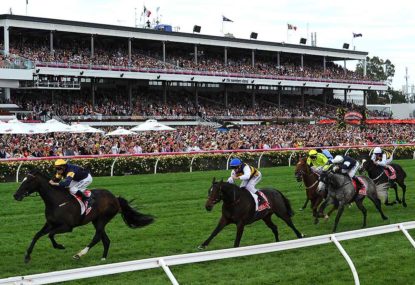TWO GOOD! Zahra wins back-to-back Melbourne Cups on Without a Fight as three horses pull up lame
Without a Fight completed the rare Caulfield Cup-Melbourne Cup double on Tuesday as star jockey Mark Zahra went back-to-back in the big one after…

A lot of work is often done by punters pre-race to determine selections, but post-race analysis is often overlooked.
On any given race day, you’ll probably set out with a plan of what you’re going to back, so at the end of the day, it makes sense to review how that plan went. Which of your selections were successful? Which weren’t? Why?
Some of these answers can be found in the race replays – things that may not be obvious in the live running of the race. This applies not only to your selections but also to the other runners in the race.
The biggest trap in watching replays is there’s always a tendency to concentrate on runners that are flying home. It’s natural, they capture your eye and often mentioned by the race caller.
Purely sticking to these runners is likely to have you come up with a horse that will start favourite next start and may let you down again and again. We all know there are some horses that are professionals at running on.
This doesn’t mean ignoring horses flashing home. I place a lot of emphasis on horses who are finishing their race off strongly, but to quantify these sorts of runs it’s imperative to consider the pace of the race. It is not always those horses who are ‘flashing home’ that are the ones finishing their race off best.
I like to watch a race replay in its entirety at full speed just so I can get a feel for what the pace of the race was like and whether the field settled. For example, did a horse lead that was expected to, did any horses miss the start – et cetera, et cetera.
Also, keep an eye out for where the eventual winner of the race was positioned in the run. Did it have a cushy run (for example on the fence behind the pace) which may have flattered it?
Did any runners get interfered with that cost them badly and how were they ridden after that? Sometimes beaten margins can be exaggerated once the horse is out of winning contention.
The next step is to watch the race again, this time using the pause button to make more specific mental notes on what is going on based on the observations from the first run through.
For example, if a short-priced favourite had an easy run in front and is a known leader, but in this race stops in the straight, I will note that it was either disappointing or perhaps injured.
If another runner is three wide on the speed but keeps going to only be beaten a couple of lengths, I will likely note it down as a good run.
And for those temping ones that are ‘flashing home’ I will decide based on the pace, and the run they had in transit, whether that was a good effort or perhaps they were entitled to do so.
It’s a good idea to look at various distance markers in the race to take note of when horses started to make their runs. As an example of this, if a horse is asked to take off at the 600-metre mark, that is a long run for home, so if it is able to sustain that length of run (even if beaten a small distance), it’s a positive.
On the other hand, if a horse takes off a fair way out, and then is beaten after 200 metres of making its run, it is a sign that it is either not fit, or needs to be ridden a bit differently.
Finally, look to summarise the race in terms of what took place, and compare that against what perhaps should have taken place based on the circumstances of pace and “in running” positions.
Often, the horse that is wide on the speed but kept going to the line is missed by many in favour of the one who flashed home from the back after an easy run. Identifying this sort of thing is the value in watching race replays.
Take the time to use race replays to your advantage. Your wallet will thank you.